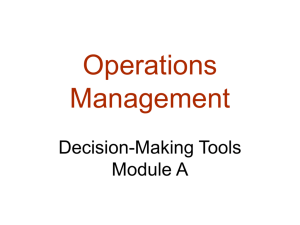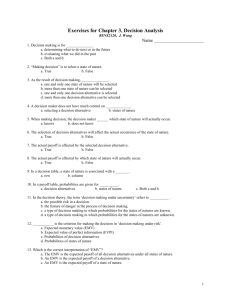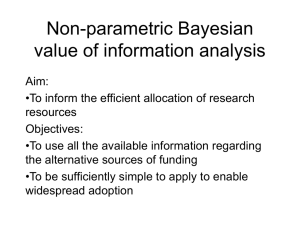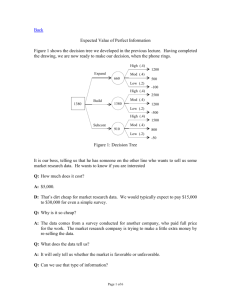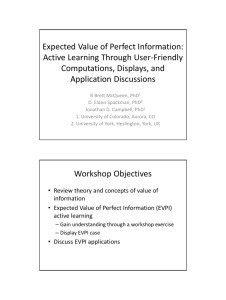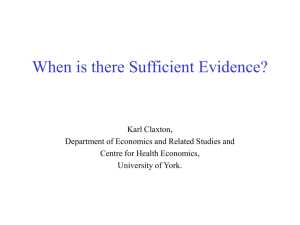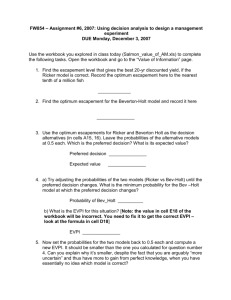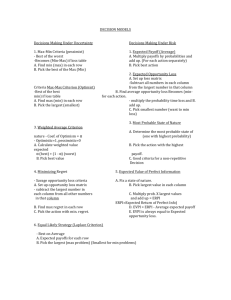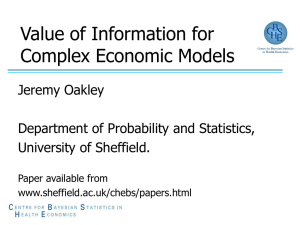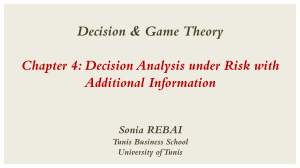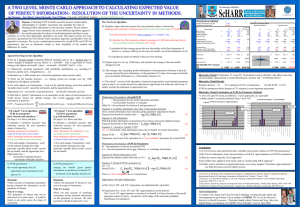Decision Analysis
advertisement
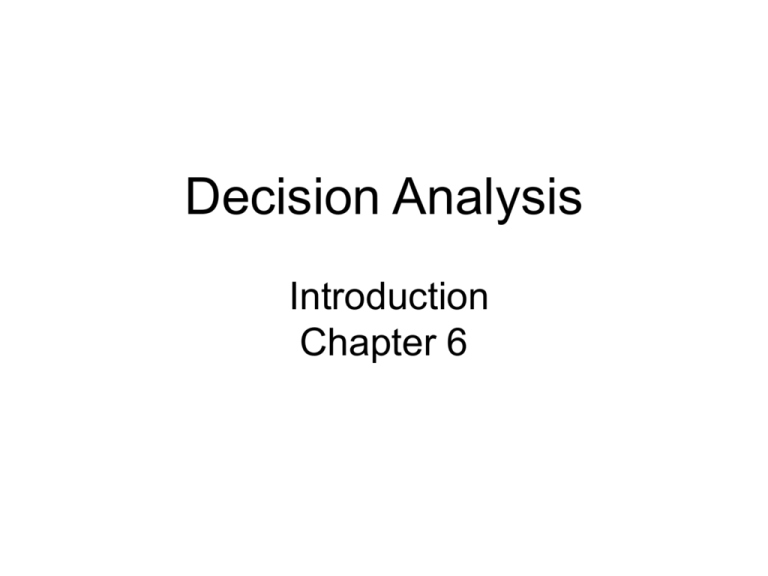
Decision Analysis Introduction Chapter 6 What kinds of problems ? • Decision Alternatives (“what ifs”) are known • States of Nature and their probabilities are known (ex. rainy 20%, partly cloudy 50%, sunny 20%) • Outcomes, (referred to as “Payoffs”) are computable under different possible scenarios –each is a combination of a decision alternative and a state of nature Decision Analysis Basic Terms • Decision Alternatives • States of Nature (eg. Condition of economy or weather) • Payoffs ($ outcome of a choice assuming a state of nature) • Criteria (i.e. Expected Value) Decision Analysis Conditions • Certainty – Decision Maker knows with certainty what the state of nature will be - only one possible state of nature • Ignorance – Decision Maker knows all possible states of nature, but does not know probability of occurrence • Risk – Decision Maker knows all possible states of nature, and can assign probability of occurrence for each state –this will be our focus Decision Making Under Certainty Decision Variable Units to build Parameter Estimates Cost to build (/unit) Revenue (/unit) Demand (units) 150 $ $ 6,000 14,000 250 Consequence Variables Total Revenue Total Cost $ 2,100,000 $ 900,000 Performance Measure Net Revenue $ 1,200,000 Decision Making Under Ignorance – Payoff Table Kelly Construction Payoff Table (Prob. 8-17) State of Nature Demand Alternative Actions Low (50 units) Medium (100 units) High (150 units) Build 50 400,000 400,000 400,000 Build 100 100,000 800,000 800,000 Build 150 (200,000) 500,000 1,200,000 Decision Making Under Ignorance Which alternative will we choose? • Maximax – Select the strategy with the highest possible return • Maximin – Select the strategy with the smallest possible loss Maximax: The Optimistic Point of View • Select the “best of the best” strategy – Evaluates each decision by the maximum possible return associated with that decision (Note: if cost data is used, the minimum return is “best”) – The decision that yields the maximum of these maximum returns (maximax) is then selected • For “risk takers” – Doesn’t consider the “down side” risk – Ignores the possible losses from the selected alternative Maximax Example Kelly Construction State of Nature Alternative Actions Demand Maximax Criterion Low (50 units) Medium (100 units) High (150 units) Max Build 50 400,000 400,000 400,000 400,000 Build 100 100,000 800,000 800,000 800,000 Build 150 (200,000) 500,000 1,200,000 1,200,000 Maximin: The Pessimistic Point of View • Select the “best of the worst” strategy – Evaluates each decision by the minimum possible return associated with the decision – The decision that yields the maximum value of the minimum returns (maximin) is selected • For “risk averse” decision makers – A “protect” strategy – Worst case scenario the focus Maximin Kelly Construction State of Nature Alternative Actions Demand Maximin Criterion Low (50 units) Medium (100 units) High (150 units) Min Build 50 400,000 400,000 400,000 400,000 Build 100 100,000 800,000 800,000 100,000 Build 150 (200,000) 500,000 1,200,000 (200,000) Decision Making Under Risk • Expected Return (ER)* – Select the alternative with the highest expected return – Use a weighted average of the possible returns for each alternative, with probabilities used as weights * Also referred to as Expected Value (EV) or Expected Monetary Value (EMV) Expected Return State of Nature Alternative Actions Demand Expected Return Low (50 units) Medium (100 units) High (150 units) ER Build 50 400,000 400,000 400,000 400,000 Build 100 100,000 800,000 800,000 660,000 Build 150 (200,000) 500,000 1,200,000 570,000 0.5 0.3 1.0 Probability 0.2 Note that we now have probabilities for each state of nature Expected Value of Perfect Information • EVPI measures how much better you could do on this decision if you could always know when each state of nature would occur, where: – EVUPI = Expected Value Under Perfect Information (also called EVwPI, the EV with perfect information, or EVC, the EV “under certainty”) – EVUII = Expected Value of the best action with imperfect information (also called EVBest ) – EVPI = EVUPI – EVUII • EVPI tells you how much you are willing to pay for perfect information (or is the upper limit for what you would pay for additional “imperfect” information!) Expected Value of Perfect Information State of Nature Alternative Actions Demand Expected Return Low (50 units) Medium (100 units) High (150 units) ER Build 50 400,000 400,000 400,000 400,000 Build 100 100,000 800,000 800,000 660,000 Build 150 (200,000) 500,000 1,200,000 570,000 0.2 0.5 0.3 1.0 400,000 800,000 1,200,000 840,000 EVPI 180,000 Probability Best Decision Using Excel to Calculate EVPI: Formulas View Kelly Construction A 1 2 3 4 5 6 7 8 9 10 11 12 13 14 Payoffs Alternatives Build 50 Build 100 Build 150 Probability Best Decision B C States of Nature Low (50 units) Medium (100 units) 400000 400000 100000 800000 -200000 500000 0.2 0.5 =MAX(B5:B7) =MAX(C5:C7) D E Expected Return High (150 units) ER 400000 =SUMPRODUCT(B5:D5,B$8:D$8) 800000 =SUMPRODUCT(B6:D6,B$8:D$8) 1200000 =SUMPRODUCT(B7:D7,B$8:D$8) 0.3 =MAX(D5:D7) EVwPI = =SUMPRODUCT(B9:D9,B8:D8) EVBest = =MAX(E5:E7) EVPI = =E11-E12

